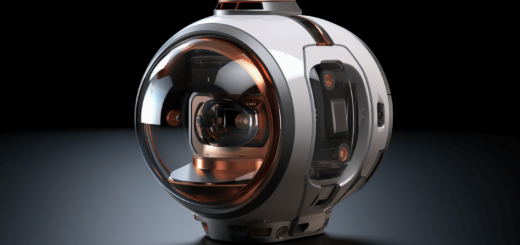Behind the Lens: The History and Evolution of Camera Technology
In today’s fast-paced, digital world, capturing moments has become an essential part of our lives. Whether it’s a breathtaking landscape, a precious family photo, or a candid selfie, we rely on camera technology to freeze those special moments in time. But have you ever wondered about the history and evolution behind the lens?
From the pinhole camera of ancient times to the high-tech DSLRs and smartphones of today, camera technology has come a long way. It has revolutionized the way we capture and share images, making photography more accessible and enjoyable for everyone.
In this article, we delve into the fascinating world of camera technology. We’ll explore the decrease in digital camera shipments over the years, the projected growth of the camera technology market, and the rising demand for sensors that fuel these remarkable devices. So, grab your gear and join us as we uncover the stories behind the lens!
Decrease in Digital Camera Shipments
In today’s fast-paced and technology-driven world, the way we capture, store, and share our memories is constantly evolving. One such evolution has been the rise of digital cameras, which have become incredibly popular over the past few decades. However, despite their initial surge in popularity, digital camera shipments have seen a significant decrease in recent years, marking a shift in consumer behavior and preferences.
According to data provided by insert link text, digital camera shipments have witnessed a dramatic decline over the past decade. In 2010, the industry shipped over 121 million units worldwide. Fast forward to the present, and that number has plummeted to a mere eight million units. This staggering drop reflects a seismic shift in the way consumers choose to capture and preserve their precious moments.
Several factors can explain this decline in digital camera shipments. Let’s explore some of these factors in more detail:
- Smartphone Photography: One of the primary reasons for the decrease in digital camera shipments is the rise of smartphones equipped with high-quality cameras. Gone are the days when people used to carry a separate camera to capture photos. Now, most consumers rely on their smartphones as their go-to device for taking pictures and videos. The convenience and portability of smartphones have made them the preferred choice for capturing spontaneous moments on the go.
- Improved Phone Camera Technology: Smartphone manufacturers have invested heavily in developing cutting-edge camera technology, equipping their devices with high-resolution sensors, multiple lenses, and advanced image processing capabilities. As a result, the gap in image quality between digital cameras and smartphones has significantly narrowed, making it difficult for consumers to justify investing in a standalone camera.
- Social Media and Instant Sharing: The rise of social media platforms like Instagram, Facebook, and Snapchat has transformed the way we share our photos. Instant sharing and the ability to connect with friends and family in real-time have become the norm. Smartphones offer seamless integration with these social media platforms, allowing users to snap a photo and share it with the world with just a few taps. This convenience has further diminished the demand for digital cameras.
- Cost and Maintenance: Digital cameras, especially high-end models, can be quite expensive. They require additional accessories, such as lenses, tripods, and memory cards, which further add to the overall cost. On the other hand, smartphones offer a more affordable option, with camera capabilities that continue to improve with each new model. Additionally, smartphones eliminate the need for maintenance and repair associated with standalone cameras.
It’s important to note that while digital camera shipments have declined, there is still a dedicated market for professional photographers, enthusiasts, and those who prioritize superior image quality. However, for the average consumer looking for convenience and quality, smartphones have become the go-to option.
In conclusion, the decrease in digital camera shipments can be attributed to the emergence of smartphones as the primary device for capturing and sharing photos. The convenience, affordability, and ever-improving camera technology of smartphones simply outweigh the need for a standalone camera for most consumers. As technology continues to advance, it will be interesting to see how the photography landscape evolves and what new innovations lie ahead.
Projected Growth of Camera Technology Market
The global camera technology market is expected to experience significant growth in the coming years. With advancements in technology and the increasing demand for high-quality imaging solutions, the market is set to expand at a rapid pace. According to industry projections, the camera technology market size is predicted to reach US$25.3 billion by 2032, growing at a compound annual growth rate (CAGR) of 12% from 2022[1].
Driving Factors for Growth
Several factors contribute to the projected growth of the camera technology market. These include:
- Technological Advancements: The constant evolution and innovation in camera technologies are driving market growth. From better image sensors to improved autofocus capabilities, manufacturers are constantly pushing the boundaries of what cameras can do. This push for innovation is expected to attract both professional photographers and general consumers alike, fueling market growth[2].
- Increasing Demand for High-Quality Imaging: As digital content creation becomes increasingly important across various industries, the demand for high-quality imaging solutions is growing. From professional photographers and videographers to content creators on social media, there is a consistent need for cameras that can deliver stunning visuals. This demand is expected to drive the market forward, as manufacturers strive to meet the growing expectations of consumers[3].
- Growing Adoption of Cameras in Automotive and Surveillance Industries: Cameras are no longer limited to just photography and videography. They have found applications in various industries, such as automotive and surveillance. In the automotive sector, cameras play a crucial role in advanced driver assistance systems (ADAS) and autonomous vehicles. Similarly, in the surveillance industry, cameras are widely used for security purposes. The increasing adoption of cameras in these sectors is expected to contribute significantly to market growth[2].
Market Revenue and Growth Statistics
The camera technology market’s positive growth trajectory can be further highlighted through revenue projections and growth statistics. According to industry forecasts:
- Revenue in the digital cameras market is expected to reach US$22.9 billion in 2023, with an estimated annual growth rate of 2.18% between 2023 and 2028[3].
- The advancement in camera technologies worldwide is projected to generate an additional US$8.2 billion, with a compounded growth rate of 16%[1].
All these statistics and projections indicate the immense potential for growth in the camera technology market. With ongoing technological advancements and increasing demand, the future looks promising for camera manufacturers and tech enthusiasts.
[1]: Source
[2]: Source
[3]: Source
Rise in Demand for Sensors
In today’s fast-paced world, where capturing high-quality images has become an essential part of our daily lives, the demand for advanced camera technology is on the rise. One particular aspect that has seen significant growth in recent years is the demand for sensors in cameras. These tiny but powerful components play a crucial role in capturing light and converting it into digital information, ultimately resulting in the stunning images we see.
What are sensors?
Sensors in cameras function as the digital equivalent of the film in traditional cameras. They are responsible for capturing light and transforming it into an electrical signal that can be processed by the camera’s image processor. There are primarily two types of sensors used in digital cameras: CCD (Charge-Coupled Device) and CMOS (Complementary Metal-Oxide-Semiconductor).
The advantages of CMOS sensors
CMOS sensors, with their lower production costs and efficiency in power consumption, have gained widespread popularity among camera manufacturers. They offer several advantages over CCD sensors, including:
- Higher resolution: CMOS sensors tend to have a higher pixel count, resulting in sharper and more detailed images.
- Faster readout speed: CMOS sensors can quickly process the captured data, enabling faster continuous shooting and reducing the chance of missing a crucial moment.
- Better low-light performance: CMOS sensors have improved sensitivity to light, allowing for better image quality even in challenging lighting conditions.
- Video capabilities: CMOS sensors are well-suited for capturing high-definition videos with their ability to rapidly read out data.
The impact on the camera market
The rise in demand for sensors has led to a surge in the camera technology market. As consumers increasingly prioritize image quality and versatility, camera manufacturers are constantly striving to enhance their products with more advanced sensor technologies. This competition drives innovation and results in the development of cameras that can produce exceptional images in various shooting scenarios.
Additionally, the demand for sensors is not limited to standalone cameras. Mobile devices, such as smartphones and tablets, have also witnessed a remarkable improvement in their camera capabilities, thanks to advancements in sensor technology. Today, these devices come equipped with high-resolution CMOS sensors that rival the image quality of dedicated cameras.
With the increasing popularity of social media and the need for visually appealing content, the demand for sensors is expected to continue its upward trajectory. As technology evolves, we can anticipate even more sophisticated sensors that push the boundaries of image quality and performance.
In conclusion, the rise in demand for sensors in camera technology is a testament to the growing importance of capturing high-quality images. The advancements in sensor technology have revolutionized the way we capture and share our experiences, enabling us to create stunning visuals with ease. With the constant drive for innovation in the camera market, we can expect exciting developments in sensor technology that will further enhance our photography experiences.
Frequently Asked Questions
- When was the first camera invented?
The first camera was invented in the early 19th century. The exact date and inventor are often debated, but the first practical photographic camera was developed by Louis-Jacques-Mandé Daguerre and Nicéphore Niépce in the 1820s and 1830s.
- How has camera technology evolved over time?
Camera technology has evolved significantly over time. From large and bulky film cameras, we have moved to compact digital cameras, DSLRs, mirrorless cameras, and even smartphones with high-quality built-in cameras. The evolution has brought improvements in image resolution, autofocus systems, low-light performance, video capabilities, and overall ease of use.
- What are some landmark inventions in camera technology?
Some landmark inventions in camera technology include the invention of the first commercially viable photographic process by George Eastman, the introduction of the Kodak Brownie camera, the development of the first digital camera by Steven Sasson, and the rise of smartphone cameras with advanced computational photography features.
- What are the advantages of digital cameras over film cameras?
Digital cameras offer several advantages over film cameras. These include instant preview and review of images, the ability to store a large number of photos on a memory card, easy sharing and editing of images, and the elimination of costs associated with film development and printing.
- What is the future of camera technology?
The future of camera technology is exciting. We can expect advancements in areas such as higher resolution sensors, improved low-light performance, enhanced image stabilization, faster autofocus systems, artificial intelligence-based image processing, 3D imaging, and integration of cameras with other smart devices.


